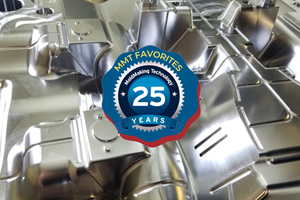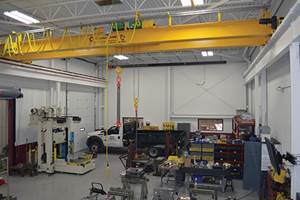Focus on Tooling Access to Improve Productivity
How to apply lean tools at leverage points in a mold shop to achieve a focused business objective.
"Our mold shop personnel are overwhelmed with work and have asked me to hire another person, and I don't want to," the vice president of manufacturing stated to a continuous improvement guide. "Can you work with them and see if we can do without the additional $60K per year expense?"
The mold shop consisted of seven associates that serviced molds from 20 plastic injection molding machines that ran three shifts. They cleaned molds between runs and repaired problems with the molds. The mold cleaning and repair workload had increased for two reasons:
- Demand for plastic parts had been increasing.
- The molding area had been systematically reducing setup times, allowing them to run smaller, more frequent batch runs. To keep up, the mold shop associates had been working overtime for several weeks, with no let up in sight.
The Challenge
The task at hand was to improve the productivity of the mold shop activities. However, sensitivity had to be practiced when considering the amount of time taken away from those stretched resources. This is not an uncommon situation. In today's global competition, most company resources are stretched. "We don't have the time," is a common refrain.
Another issue to confront was that although the mold shop associates didn't like the long hours, they liked the extra income from overtime. At the initial meeting with the mold shop associates where the marching orders from the VP were communicated, they weren't particularly pleased, but agreed to work with the continuous improvement guide toward the VP's goal.
| Table 1 | |
| Purchase | Cost |
| Mobile tool boxes | $ 2,500 |
| Additional tooling |
$ 700 |
| Additional mold kit supplies |
$ 400 |
| Continuous Improvement (CI) Guide |
$ 5,000 |
|
Total
|
$ 8,600 |
| Tables courtesy of HighlandPath. | |
The Plan
Observation was the first step. After about four hours of observation and asking questions, the observations were shared with the shop employees. At that point, they were instructed to track movements that required them to leave their worktable. A few days later everyone met and reviewed their analyses. It became obvious that they spent a considerable amount of time away from the worktable, searching for and getting items they needed. As they described their mold cleaning and repair activities, their movements were drawn on a physical flow chart (see Figure 1)—also known as a spaghetti diagram—to help paint a picture for them.
Leverage Points
Four activities stood out during the cleaning and repair of each mold. These are called leverage points—because if the shop can focus its improvement activities on these points, it will have the most impact on the overall objective that management has chartered.
- During mold cleaning and repair, three trips on average were necessary to retrieve mold change kits that were located in the back of the shop. Mold change kits contain the small spare parts that typically wear out over time—both common parts, such as springs and custom parts unique to each mold. More than one trip was necessary because the kits were not particularly well organized and maintained, and required some searching about to find items.
- Six trips on average were being taken to retrieve tools from the central tool location. Trips were made when a particular tool was needed, and since the tools were shared they needed to be returned frequently. Many of the trips didn't end at the central tool location, but continued on to other employee's tables in search of the tools they needed.
- Two trips on average were being made during mold cleaning to retrieve cleaning supplies.
- There was a long mold retrieval cycle. Molds were stored on shelves in the mold storage area that were unreachable by the jib crane. Because most of the molds weighed several hundred pounds, movement required a forklift, which was shared by the injection molding area and was in use about 30 percent of the time when a mold shop associate needed to use it.
Tool Access: The High Leverage, High Meaning Point
The mold shop associates and continuous improvement guide decided that the leverage point with the highest impact was tooling access. The Lean 5S tool of creating a tool shadow board next to the work surface was the most obvious countermeasure. However, the associates were convinced that the tools would be stolen and they could not be convinced otherwise. The proposed solution was to obtain individual mobile toolboxes stocked with tools that each mold shop person would be responsible for and could lock up when they left for the day. That seemed like a reasonable solution and was unanimous among the associates.
However, obtaining the mobile toolboxes was a more difficult task than anticipated. Upper management made a decree many years earlier that shop personnel were not allowed to hold company tools because some employees were hoarding tools and it became difficult to distinguish between tools that employees owned and those of the company. Company tools were to be used and returned to a central location in each department and only individually owned tools were allowed in personal toolboxes.
This called for a meeting with the director of human resources to explain that the way to avoid hiring another mold shop person was to allow the associates in that area to obtain toolboxes. This was acceptable as long as the associates sign an agreement that they would be personally responsible for the tools, excluding normal wear and tear. Each associate quickly and eagerly signed the agreements.
Within a week the team had pushed through the purchase order approvals and had obtained a mobile toolbox for each associate—three feet tall with five drawers and a nice work surface, and someone in maintenance created custom plastic work surface covers for them.
| Table 2 | ||
| Measure |
Before | After |
| Walking distance during a mold clean and repair | ~650 feet |
~250 feet |
| Cost avoidance | $60K/year | |
From that moment on any resistance from team members evaporated. However, this was sure to be short-lived because at some point these improvements would likely eliminate overtime pay.
Tool access turned out to be the high leverage and the high meaning point. From that point on they were highly motivated to pursue any other action and quickly implemented a slew of other improvements at the leverage points that were identified.
Actions
The team implemented actions at the four leverage points:
- Obtained mobile toolboxes and tools for each mold shop associate and organized them for ease of access for the most frequently used tools and cleaning supplies. Created a place for everything, and everything in its place by marking off locations for each tool and cleaning supply in the toolbox.
- Improved mold repair kit organization through rationalization, consolidation and a better restock signaling system. Then moved more than 80 percent of the most frequently used mold repair kits to cabinets next to worktables.
- Moved one week's worth of cleaning supplies into the mobile toolboxes. Moved the remaining bulk cleaning supplies to the back of the shop, which required only one trip per week to restock their cleaning supplies.
- Moved the most frequently used small molds under the worktables, which were accessible by the jib crane. Updated the addressing location system for the molds so the molds could be found quickly.
Results
The objective management sought was achieved—hiring another mold shop associate was avoided and overtime was eliminated (see Figure 2). Management obtained a seven-to-one payback within the first year and also obtained the additional yearly cost avoidance into perpetuity (see Table 1). Furthermore, the associates gained enough extra time to work on pet projects they had wanted to do for some time (see Table 2). This was a case where the appropriate lean tools and techniques were applied in a mold shop at leverage points to achieve a focused business objective.
Related Content
MMT Chats: Solving Schedule and Capacity Challenges With ERP
For this MMT Chat, my guests hail from Omega Tool of Menomonee Falls, Wisconsin, who share their journey with using enterprise resource planning (ERP)—and their people—to solve their schedule and capacity load monitoring challenges.
Read MoreEditorial Guidelines: Editorial Advisory Board
The Editorial Advisory Board of MoldMaking Technology is made up of authorities with expertise within their respective business, industry, technology and profession. Their role is to advise on timely issues, trends, advances in the field, offer editorial thought and direction, review and comment on specific articles and generally act as a sounding board and a conscience for the publication.
Read MoreLeading Mold Manufacturers Share Best Practices for Improving Efficiency
Precise Tooling Solutions, X-Cell Tool and Mold, M&M Tool and Mold, Ameritech Die & Mold, and Cavalier Tool & Manufacturing, sit down for a fast-paced Q&A focused on strategies for improving efficiencies across their operations.
Read MoreThe Trifecta of Competitive Toolmaking
Process, technology and people form the foundations of the business philosophy in place at Eifel Mold & Engineering.
Read MoreRead Next
Are You a Moldmaker Considering 3D Printing? Consider the 3D Printing Workshop at NPE2024
Presentations will cover 3D printing for mold tooling, material innovation, product development, bridge production and full-scale, high-volume additive manufacturing.
Read MoreHow to Use Strategic Planning Tools, Data to Manage the Human Side of Business
Q&A with Marion Wells, MMT EAB member and founder of Human Asset Management.
Read More













